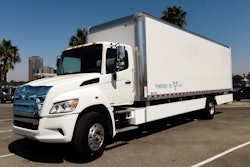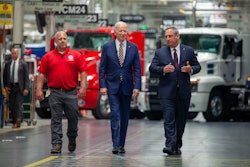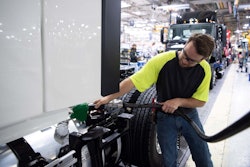The second quarter of 2021 marked a full year since the COVID pandemic plunged markets, disrupted supply chains, and catapulted the freight market to unprecedented highs. A look at the corporate earnings statements from some of the biggest fleets around shows how companies have responded to the U.S.'s uneven economic recovery and unpredictable times.
Across the top publicly traded fleets, a few themes remain constant: Rates and volumes are high, labor is short, and tech platforms hold the promise of customer satisfaction.
Here are the earnings reports from the top fleets for the second quarter (Q2) this year. Figures shown within parenthesis represent a loss.
Covenant sets records, cuts cost by 3 cents per mile
Covenant Transportation posted record-setting numbers in Q2 of 2021 with its highest-ever adjusted earnings per share of $0.96, which stands in stark contrast to 2020's Q2 EPS of $0.02. The company credited its "multiyear transformation into a full-service logistics provider" for providing various streams of revenue. Covenant's CEO, David Parker, said the firm had room to improve in its dedicated segment but had fared better than expected with expedited freight and the asset-light managed freight segment. Overall, Parker sees "freight market demand firing on all cylinders" and expects the market to stay strong into the third quarter and beyond.
"The key highlights of the quarter were our operating freight revenue grew 29% to $232 million compared to the 2020 quarter. Second, our asset-based truckload group revenue grew 9% versus the second quarter of 2020 with 369 less trucks. Our less asset-intensive Managed Freight and warehouse segments grew a combined 89% compared to the second quarter of 2020," said Covenant Logistics Group President Joey Hogan. "On the safety side, despite rising casualty insurance premiums, we produced another solid quarter with our DOT accidents per mile being 7% below the year ago period and our total cost down approximately 3-cents per mile."
Revenue: 2021 YTD: $477.2 million vs. 2020 YTD $402.5 million
2021 2Q: $256.3 million vs. 2020 2Q: $191.6 million
Income: 2021 YTD: $28.8 million vs. 2020 YTD: ($30. million)
2021 Q2: $18.3 million vs. 2020 Q2: ($28.9 million)
–
Heartland Express wipes out debt, cashes in on high demand
Heartland Express saw a 9.5% increase in operating income, its strongest quarter of operating income since the second quarter of 2019. Mike Gerdin, the company's CEO, said company managed to "build cash to $167.2 million at the end of the quarter without any debt on our balance sheet," but that it still needed to rein in the operating ratio in the Millis Transport fleet, which it acquired in 2019.
"Our operating results for the three and six months ended June 30, 2021 showed strength in terms of profit, overall operating efficiency, and our continued ability to build cash to $167.2 million at the end of the quarter without any debt on our balance sheet. Freight demand continued to be strong throughout the second quarter of 2021 and is expected to continue to be strong for the remainder of 2021. We also believe that hiring and retaining safe and professional drivers will be the number one challenge in order to fully capitalize on the expected freight demand. We have increased wages and enhanced the compensation features for our drivers multiple times in the last nine months. Further, we have continued to get more creative in providing better pay, benefits, equipment, and facilities for our drivers. While this same employment challenge is facing many businesses in America today, we believe it is more pronounced within our industry. Given that, we intend to continue to invest in our drivers and in creative strategies to address this significant challenge in the months ahead.”
Revenue: 2021 YTD: $306.5 million vs. 2020 YTD: $327.1 million
2021 Q2: $154.1 million vs. 2020 Q2: $160.8 million
Income: 2021 YTD: $45.6 million vs. 2020 YTD: $42.3 million
2021 Q2: $27.3 million vs. 2020 Q2 $24.9 million
—
J.B. Hunt chalks up monster quarter to growth in its Marketplace product
J.B. Hunt's operating revenue jumped 36% to $2.9 billion over Q2 2020 while it experienced double-digit growth in all segments, year over year. According to the company's press release: "Integrated Capacity Solutions (ICS) and Truck (JBT) grew revenue 100% and 70% year-over-year, respectively, as both segments were able to source and secure capacity for customers in the Marketplace for J.B. Hunt 360°."
That marketplace brought in $500 million in revenue, dwarfing the $281 million it brought in 2020. The company chalked up the growth in trucking revenue to an increase in revenue per load that was driven by a 40% increase in revenue per loaded mile and a 13% increase in average length of haul. (All figures excluding fuel surcharge revenue.)
Revenue: 2021 YTD: $4.9 billion vs. 2020 YTD: $4 billion
2021 Q2: $2.6 billion vs. 2020 Q2: $1.9 billion
Income: 2021 YTD: $449.1 million vs. 2020 YTD: $329.9 million
2021 Q2: $241.5 million vs. 2020 Q2: $175.1 million
—
Knight-Swift Transportation comes roaring back from pandemic lows
Knight-Swift suffered during the pandemic, but has come roaring back to life in 2021 with a and Adjusted Net Income $163.0 million, which represents a 68.9% increase from $96.5 million from Q2 of 2020. Within trucking, the company dropped its operating ration from more than 85% to 80.9% and saw growth of 8.6%. The firm credited its "unique and unmatched terminal network and industry-leading trailer pool capacity" for this growth and projected continued growth in the tight freight market as a "the result of having invested significant capital and many years in developing a powerful combination of assets, technologies, people, and customer relationships toward producing distinctive value to our customers."
"We believe truckload shippers are recognizing the value of our unique and unmatched terminal network and industry-leading trailer pool capacity. Our strong performance in recent quarters is the result of having invested significant capital and many years in developing a powerful combination of assets, technologies, people, and customer relationships toward producing distinctive value to our customers. We are energized by our recent results, including the growing adoption of our power-only services by small carriers, and even more excited about our plans already underway to drive further growth, meaningful returns, and less cyclicality in the future," Dave Jackson, CEO of Knight-Swift said.
Revenue: 2021 YTD: $2.5 billion vs 2020 YTD: $2.1 billion
2021 Q2: $1.3 billion vs. 2020 Q2: $1 billion
Income: 2021 YTD: $253.3 million vs. 2020 YTD: $204.2 million
2021 Q2: $191.1 million vs. 2020 Q2: $102.1 million
—
Landstar Systems sees a bump in truckload volume, sets income records
Landstar System, Inc., reported all-time highs in quarterly net income at $92.3 million, or $2.40 per diluted share, in Q2 2021 as well as a record quarterly revenue of $1.571 billion. Fully 92% of that revenue came from truck transportation hauled by independent business capacity owners.
“Our truckload volume in the second quarter exceeded the 2021 first quarter by over 12 percent, the second largest first quarter to second quarter increase in over 10 years. This outperformance was particularly impressive considering we were following an already record-setting first quarter. We attribute this strong demand to an ongoing, broad-based economic recovery, with particular strength in consumer spending, that has been a big driver of freight activity," said Landstar President and CEO Jim Gattoni.
Revenue: 2021 YTD: $2.8 billion vs. 2020 YTD: $1.7 billion
2021 Q2: $1.5 billion vs. 2020 Q2: $823.5 million
Income: 2021 YTD: $225.5 million vs. 2020 YTD: $86.1 million
2021 Q2: $122.2million vs. 2020 Q2: $42.4 million
—
Marten Transport credits workers for boosting revenue, income
Marten Transport reported in Q2 of 2021 the highest operating revenue and operating income in the company's history and its best operating ratio since 1986. According to Randolph L. Marten, the company's executive chairman, the strong numbers owe to the "talented and disciplined people" at Marten who "capitalized on the continuing tight freight market." The company's truckload division brought in the most income ($13.1 million), followed by its dedicated segment ($10.6 million), then its brokerage ($2.8 million) and finally its intermodal segment ($1.1 million).
“We have been increasing and will continue to increase the compensation from our customers for our premium services within the constrained freight market largely caused by the unrelenting national shortage of qualified drivers. We are also heightening our emphasis on structurally improving our drivers’ jobs and work-life balance by collaborating with our customers,” said Marten.
Revenue: 2021 YTD: $455.4 million vs. 2020 YTD: $431million
2021 Q2: $232.4 million vs. 2020 Q2: $212.3 million
Income: 2021 YTD: $39.3 million vs. 2020 YTD: $25.2 million
2021 Q2: $28.5 million vs. 2020 Q2: $25.2 million
—
Old Dominion dominates in LTL
Old Dominion set records for quarterly revenue, operating ratio and earnings per diluted share in Q2 2021 thanks, in part, to a 28.1% increase in LTL tons and a 14.9% increase in LTL revenue per hundredweight, the company said. The company said its improvements in managing LTL runs and their weight increased profitability, as well as improvements in freight density and yard management.
“Old Dominion’s second quarter financial results include new Company records for quarterly revenue, operating ratio and earnings per diluted share. We achieved these record results by continuing to execute on the fundamental aspects of our long-term strategic plan, which is centered on our ability to provide superior service at a fair price. In addition, our strategy of continuously investing in our service center network has provided us with capacity to support additional revenue growth. These factors, combined with a domestic economy that continues to improve, have driven a significant increase in the demand for our superior service. As a result, the sequential acceleration in our revenue during the second quarter was once again well above our normal sequential trends," said Old Dominion president and CEO Greg C. Gantt.
Revenue: 2021 YTD: $2.4 billion vs. 2020 YTD: $1.8 billion
2021 Q2: $1.3 billion vs. 2020 Q2: $896.2 million
Income: 2021 YTD: $139.3 million vs. 2020 YTD: $83.8 million
2021 Q2: $635.7 million vs. 2020 Q2: $382.3 million
–
P.A.M. Transport goes from 'scrambling to find replacement freight' to 'record revenue'
P.A.M. Transport showed an almost 40% bounce in YTD revenue over a troubled 2020 and a 73% bump in operating revenues over Q2 of 2020. Following the strong quarter, the company's board approved a stock split.
'It was only one year ago that we were scrambling to find replacement freight as many of our largest customers reacted to the pandemic by completely suspending their operations. Now, just one year later and with a redesigned network, we are pleased to report record revenue and record operating income for the quarter. I have been really impressed with the progress our team has achieved in such a short timeframe, and I want to thank our driving associates for the work they put in every single day. We couldn't achieve any of this without their efforts. While we believe that there remains plenty of opportunity to improve on our recent operating results and we expect our team to continue to exceed expectations, it is satisfying to see such marked improvement so quickly," Joe Vitiritto, the company's president said.
Revenue: 2021 YTD: $310.1 million vs. 2020 YTD: $222.1 million
2021 Q2: $161.1 million vs. 2020 Q2: $92.9 million
Income: 2021 YTD: $34.6 million vs. 2020 YTD: $7.4 million
2021 Q2: $21 million vs. 2020 Q2: ($2 million )
—
Schneider National fires on all cylinders
Schneider National found major success across its many segments due to the tight freight market and huge demand for goods. In its truckload segment, the company prioritized multiyear dedicated contract configurations, which could bode well for the company as rates are currently high. Broadly, Schneider identified the driver shortage as a roadblock to further gains but predicts rates will remain high for the near future.
“In the second quarter, we continued to utilize our diverse portfolio to capitalize upon opportunities presented by challenging market conditions,” said Mark Rourke, Chief Executive Officer and President of Schneider. “Our asset-light segments accounted for 60% of revenues in the quarter, demonstrating the integration of our scaled, multimodal service offerings. Our Truckload segment operating ratio improved 700 basis points from the first quarter of 2021 to 84.5% despite the protracted driver capacity challenges. Our Intermodal segment grew both orders and revenue per order sequentially which contributed to nearly a 500 basis point sequential improvement in operating ratio. Our Logistics segment achieved record revenue and more than 100% earnings growth year over year, supported by constructive market conditions and further leverage of Schneider FreightPower.”
Revenue: 2021 YTD: $2.5 billion vs. 2020 YTD: $2.1 billion
2021 Q2: $1.3 billion vs. 2020 Q2: $1.0 billion
Income: 2021 YTD: $202 million vs. 2020 YTD: $118.3 million
2021 Q2: $125.8 million vs. 2020 Q2: $63.4 million
—
USA Truck rides high as volume, rates surge
USA Truck posted record-setting earnings per share for the company's fourth straight quarter, and also set an all-time revenue record in Q2 of 2021. USA Truck president and CEO James Reed said "the pricing environment remains strong," and "Equipment delivery schedules have slipped and that has affected our fleet age and costs performance, but profitability has improved."
"As a result of these efforts, our Trucking segment adjusted operating ratio(a) improved 140 basis points year over year to 96.4%. USAT Logistics load volume increased 11.2% with revenue up 103.3% year over year and the increased volumes and pricing drove an improvement in adjusted operating ratio(a) for the 2021 Quarter of 580 basis points year over year to 94.7%,” said Reed.
Revenue: 2021 YTD: $328.5 million vs. 2020 YTD: $250.5 million
2021 Q2: $170 million vs. 2020 Q2: $123.7 million
Income: 2021 YTD: $12.9 million vs. 2020 YTD: ($1.3 million)
2021 Q2: $6.9 million vs. 2020 Q2: $1 million
—
U.S. Xpress sees YoY revenue drop, looks into self-driving trucks
U.S. Xpress saw a drop in revenue compared to Q2 of 2020 of nearly 50%, but remains in growth mode on a year-over-year basis. The company's CEO, Eric Fuller, said he was focused on the "digital transformation plan," which he hopes will help double revenue and expand margins over the next four years. which underpins our goal to double revenue and significantly expand margins over the next four years. The company grew its fleet to 1,160 tractors and saw its brokerage business more than double in revenue. It has also heavily invested in self-driving trucks.
“Operationally, second-quarter results in our Brokerage and Dedicated divisions were positive. Brokerage revenue increased 110% year-over-year while gross margin expanded, and the percentage of digital transactions increased to 74.7%, and the segment swung to profitability versus a loss in the second quarter last year. Meanwhile, average revenue per tractor in Dedicated improved 5% to a new second-quarter record of $4,336 per week," said Fuller.
Revenue: 2021 YTD: $925.7 million vs. 2020 YTD: $855 million
2021 Q2: $475 million vs. 2020 Q2: $422.4 million
Income: 2021 YTD: $16.9 million vs. 2020 YTD: $12.6 million
2021 Q2: $8.9 million vs. 2020 Q2: $16.2 million
–
Werner sees labor challenges, but sets records all the same
Like many companies on this list, Werner credited the strong freight market for gains in revenue and income while blaming a labor shortage for holding off further gains. In the first quarter of 2020, Werner invested in self-driving trucking company TuSimple. Immediately following the second quarter on July 1, Werner acquired an 80% stake in a 500-truck regional fleet, ECM.
“Werner achieved record second quarter results based on our strong execution in a robust freight market,” said Derek J. Leathers, Chairman, Werner's president and CEO. “The rapidly recovering economy combined with a severely constrained driver market is presenting labor challenges for customers and carriers alike. I am proud of the Werner team for working tirelessly and creatively to provide our customers with best-in-class solutions and superior performance.”
Revenue: 2021 YTD: $1.2 billion vs. 2020 YTD: $1.1 billion
2021 Q2: $649.8 million vs. 2020 Q2: $568.9 million
Income: 2021 YTD: $139.3 million vs. 2020 YTD: $83.8 million
2021 Q2: $76.8 million vs. 2020 Q2: $52.8 million
--
Yellow rides strong demand for LTL capacity, adds almost 2,000 tractors
Yellow Corporation reported second quarter operating revenue of $1.313 billion and operating income of $27.0 million compared to operating revenue in the second quarter 2020 of $1.015 billion and an operating loss of $4.6 million.
Darren Hawkins, Yellow chief executive officer, said strong customer demand and an industry-wide shortage of qualified drivers are contributing to tight capacity and a favorable yield environment. "Sequentially, LTL revenue per hundredweight increased 7.6% in the second quarter 2021 compared to first quarter 2021 and 16.2% compared to a year ago," he said. "This contributed to a nearly 30% increase in second quarter revenue compared to last year when the U.S. economy was severely impacted by the initial stages of the COVID-19 pandemic. With inventories below normal levels and U.S. manufacturing expected to return to full strength once the microchip shortage ends, demand for LTL capacity is positioned to remain strong into 2022."
Through the first half of 2021, Hawkins said the company has acquired more than 1,800 tractors, 2,200 trailers and 400 containers – investments he expects to "enhance safety, improve fuel efficiency, reduce maintenance expense and augment our sustainability efforts."
Revenue: 2021 YTD: $2.5 billion vs. 2020 YTD: $2.1 billion
2021 Q2: $1.3 billion vs. 2020 Q2: $1 billion
Income: 2021 YTD: -$600,000 vs. 2020 YTD: $23.4 million
2021 Q2: $27 million vs. 2020 Q2: -$4.6 million














